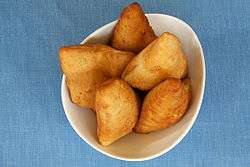Mandazi
Mandazi (Swahili: Mandazi, Maandazi), is a form of fried bread that originated on the Swahili Coast. It is one of the principal dishes in the cuisine of the Swahili people who inhabit the Coastal Region of Kenya and Tanzania [2][3] The dish is popular in the region, as it is convenient to make, can be eaten with almost any food or dips or just as a snack by itself, and can be saved and reheated for later consumption.[4][5]
 Bowl of mandazi | |
| Alternative names | Swahili Bun, Swahili Coconut Doughnut, mahamri/mamri (when made with coconut milk) [1] |
|---|---|
| Place of origin | Tanzania, Kenya, Uganda, Rwanda, Burundi [1] |
| Region or state | African Great Lakes |
| Serving temperature | Warm or room temperature |
| Main ingredients | Water, sugar, flour, yeast, and milk (Coconut milk in mahamri or mamri) |
| Variations | Various ingredients added such as coconut milk, peanuts, or almonds |
Characteristics
Mandazi are similar to doughnuts, having a little bit of a sweet taste which can be differentiated with the addition of different ingredients. However; they are typically less sweet than the United States style of doughnuts and are usually served without any glazing or frosting.[6] They are frequently made triangular in shape (similar to samosas), but are also commonly shaped as circles or ovals.[7] When cooked, they have a "fluffy" texture.
Preparation
Mandazi are made by briefly cooking the dough in cooking oil. The ingredients typically used to make mandazi include water, sugar, flour, yeast, and milk. Coconut milk is also commonly added for sweetness.[8][9] When coconut milk is added, mandazi are commonly referred to as mahamri or mamri.[10] Ground peanuts and almonds, among other ingredients, can also be used to add a different flavor. After being cooked, they can be eaten warm or left to cool down. They are popular in the African Great Lakes region, as they can be eaten in accompaniment with many things. They are commonly made in the morning or the night before, eaten with breakfast, then re-heated in the evening for dinner.[4] Mandazi are also commonly eaten with tea or fresh fruit juice, or are eaten as snacks by themselves. Different dips, often fruit flavored, can be used to add various tastes.[11] Mandazi can also be eaten as a dessert after a meal where it is often served with powdered or cinnamon sugar to add sweetness.[5] They are also a popular snack in the region.
See also
- Beignet – Deep fried pastry, a similar pastry from New Orleans
- List of fried dough foods – Wikimedia list article
- Ox-tongue pastry, a similar Chinese pastry
- Puff-puff – African fried dough snack
References
| Wikimedia Commons has media related to Mandazi. |
- "Mandazi Doughnuts". Atlas Obscura. Retrieved 2019-06-11.
- "MANDAZI : SWAHILI buzarelististBUNS". COOKS.COM. Retrieved 24 July 2014.
- "Swahili Coconut Donuts ('Mandazi' in Swahili) Recipe". Family Cookbook Project. Retrieved 24 July 2014.
- Peck, Richard. "Swahili Recipes". Lewis & Clark. Archived from the original on 2010-02-27. Retrieved 2009-11-13.
- "Kenyan Cookbook". Expanding Opportunities. Archived from the original on 2009-06-05. Retrieved 2009-11-13.
- "Mandazi Recipe". SparkRecipes. Retrieved 2009-11-13.
- Kende, Eva. "Recipes (Mandazi)". Canadian eAuthors. Archived from the original on 2009-12-21. Retrieved 2009-11-13.
- "Jinsi ya Kupika Maandazi ya Nazi". Active Chef Issa Kapande. Retrieved 2014-02-05.
- "MaandaziRecipe". Taste of Tanzania by Mariam Kinunda. Retrieved 2014-02-05.
- Solomon Katz, ed. (2003 (2006 on eNotes)). East Africa. Encyclopedia of Food & Culture. 1. Gale Cengage. Retrieved 2009-11-16. Check date values in:
|date=(help) - "Sample Menu". Kitoweo. Archived from the original on 2010-11-30. Retrieved 2009-11-17.